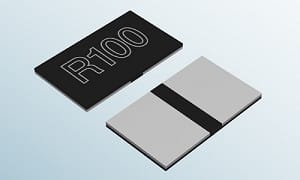They include newly developed low-ohmic chip resistor series and ultra-low-ohmic resistor PSR series with increased rated power
 The requirement for low power consumption in higher power applications, especially with respect to automotive and industrial fields has witnessed an increase in recent years. This in turn requires shunt resistors that support high power and high accuracy current detection to achieve high-efficiency operation in a variety of applications.
The requirement for low power consumption in higher power applications, especially with respect to automotive and industrial fields has witnessed an increase in recent years. This in turn requires shunt resistors that support high power and high accuracy current detection to achieve high-efficiency operation in a variety of applications.
Therefore, ROHM Semiconductor has announced that it has developed the GMR320 series of shunt resistors featuring a rated power of 10W. Designed for high power applications, the GMR320 series is suitable for automotive applications, industrial equipment and home appliances.
It has a resistance value range from 5mΩ to 100mΩ at a rated power of 10W, making it ideal for automotive engine ECUs and headlamps, as well as, motors and power supplies for industrial equipment and home appliances.
A unique structure and optimised materials allow the GMR320 series to reduce surface temperature increase by 23 per cent, ensuring high ruggedness against overcurrent loads even though it has the smallest size among 10W class resistors. Additionally, a high-performance metal alloy for the resistive material provides low Temperature Coefficient of Resistance (TCR), which makes it reliable and highly accurate while detecting current detection even in the low resistance values.
Besides the offered GMR series, the PSR series, which is widely used as high-power shunt resistors, has an increased maximum rated power (by up to 15W) and enhanced TCR value by applying the terminal temperature derating method. Ultra-low resistance value from 0.1mΩ to 3.0mΩ can be offered, and higher rated power and high accuracy of current detection are provided in a compact package, contributing to greater miniaturisation in automotive and industrial applications same as GMR series.
All this makes it possible to perform simulations before designing the actual products, even in high power applications where thermal design is particularly difficult, reducing design man-hours considerably.
This will make design simulations a possibility before designing the actual products, even in high power applications where thermal design is particularly difficult, reducing design man-hours considerably.
Key Features
- High heat dissipation structure reduces surface temperature rise by 23% over standard products: An issue when using shunt resistors at high power is suppressing the rise in surface temperature of the product. GMR320 series improves heat dissipation by conducting a thorough review of materials and adopting a proprietary structure that significantly suppresses surface temperature rise.
For example, when a 5mΩ product is used at 7W, the surface temperature is suppressed to rise to just 117.8 degrees Celsius (compared to 154.3 degrees Celsius), a difference of 23 per cent.
Moreover, superior heat dissipation in the 10W class ensures stable performance without a change in resistance value even at overcurrent loads.
2. Excellent temperature coefficient of resistance – even in the low resistance region: Generally, the lower the resistance the higher the temperature coefficient of resistance (TCR). However, the GMR320 series utilises a high-performance alloy for the resistive element that ensures a very low TCR of ±25ppm/°C or less, even in the low-resistance range. This limits the resistance drift due to heating-up to about half that of standard products in the low-resistance range, enabling high accuracy current detection that improves application reliability.
Design Support Tools
From October 2021, thermal simulation models for shunt resistors will be available on ROHM’s website. These models allow thermal design (which is a major issue during application design) to be simulated in advance, reducing design man-hours.
Both the PSR and GMR series are qualified under the AEC-Q200 automotive reliability standard for passive components, ensuring a maximum operating temperature of 170°C that provides high reliability even in vehicle environments where temperatures can be particularly severe, such as in the engine compartment.
The devices are in mass production now.










